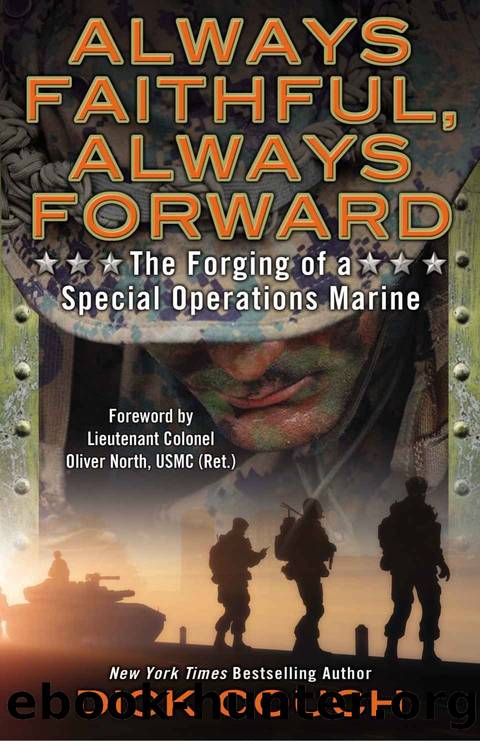Always Faithful, Always Forward: The Forging of a Special Operations Marine by Dick Couch

Author:Dick Couch [Couch, Dick]
Language: eng
Format: epub
Publisher: Penguin Group US
Published: 2014-06-03T00:00:00+00:00
CHAPTER SIX
PHASE TWO:
SPECIAL RECONNAISSANCE
Their drills were bloodless battles and their battles, bloody drills.
FLAVIUS JOSEPHUS
Special reconnaissance, or SR, along with foreign internal defense, direct action, counterterrorism, and counterinsurgency, is a standing core activity for Marine Special Operations Forces. Special reconnaissance training, as a separate phase of the Individual Training Course for Marine Critical Skills Operators, is new to the ITC. For the previous nine Individual Training Courses, SR training was the last two weeks of Phase One and took place following the Raider Spirit exercise. For Class 1-13, it is a stand-alone phase and, for this class only, a shortened three-week phase.
Special reconnaissance is all about careful observation, detection avoidance, and imagery capture. These three disciplines are taught in this phase and then interwoven into the tactical flow of mission tasking, courses of action development, mission planning, and mission execution. The first week of the phase for 1-13, a shortened four-day week due to the long Easter weekend, has to do with âseeing it right.â This is in keeping with much of MARSOC training that follows a crawl-walk-run format. This entails seeing it right, doing it under instruction, and then doing it under tactical training conditions. As a point of departure, special reconnaissance is different in concept from reconnaissance and surveillance as practiced throughout the Army and Marine Corps as a standard battle tactic. R&S is typically thought of as reconnaissance and intelligence gathering in preparation for, or to accompany, an immediate military action, such as a conventional ground assault. SR as practiced in special operations could well serve a conventional R&S mission role, but it is an enhanced capability for strategic, politically sensitive, intelligence-related, or evidentiary requirements. Week one of the SR Phase is all classroom work for Class 1-13 and a welcome change of pace for these weary students. Classroom work means that for this week, and this week alone, they will sleep in the barracks and in their beds. As with Raider Spirit, the balance of SR will be fieldwork. This means they will be in patrol bases, hide sites, or field mission-support sites much of the time. When they sleep, they will be curled up in sleeping bags with a weapon within armâs reach. And seldom will they sleep for more than two hours at a time.
Special-reconnaissance observation is usually done from a fixed location or what is called a hide site. Hide sites are generally classed as rural or urban, with many subclassifications and adaptations. A rural hide site could be a position just inside a densely wooded tree line or a stand of covering foliage. The site may be suitable in its natural condition for hiding the observer for a short period of observation time, or may be dug in to allow the SR observer to safely and clandestinely have âeyes-onâ for an extended time. These rural hide sites are typically a shallow foxhole, large enough for two or three Marines and roofed with bow supports, a poncho ground-cloth covering, and finished with a covering of natural vegetation.
Download
This site does not store any files on its server. We only index and link to content provided by other sites. Please contact the content providers to delete copyright contents if any and email us, we'll remove relevant links or contents immediately.
| Africa | Americas |
| Arctic & Antarctica | Asia |
| Australia & Oceania | Europe |
| Middle East | Russia |
| United States | World |
| Ancient Civilizations | Military |
| Historical Study & Educational Resources |
The Light of Days by Judy Batalion(1053)
First Platoon: A Story of Modern War in the Age of Identity Dominance by Annie Jacobsen(889)
Stalin's War: A New History of World War II by Sean McMeekin(853)
The Pacific War 1941-1943 by James Holland(796)
Walk in My Combat Boots by James Patterson(758)
The American War in Afghanistan by Carter Malkasian(736)
Victory's Price (Star Wars) by Alexander Freed(727)
The Vietnam War: An Intimate History by Geoffrey C. Ward & Ken Burns(712)
Blood and Ruins: The Great Imperial War, 1931-1945 by Richard Overy(680)
Operation Pedestal by Max Hastings(676)
Concepts of Space by Jammer Max;(662)
Cold War (Alexander King Book 2) by Bradley Wright(654)
Extreme Fitness by Chris McNab(649)
The Madman Theory by Jim Sciutto(645)
Flying Tiger by Samson Jack(626)
World War II Infantry Fire Support Tactics by Gordon L. Rottman(607)
Pathfinders by AL-KHALILI JIM(604)
Panzerkrieg by Mike Syron(594)
Hitler’s Pre-Emptive War: The Battle for Norway, 1940 by Henrik O. Lunde(578)
